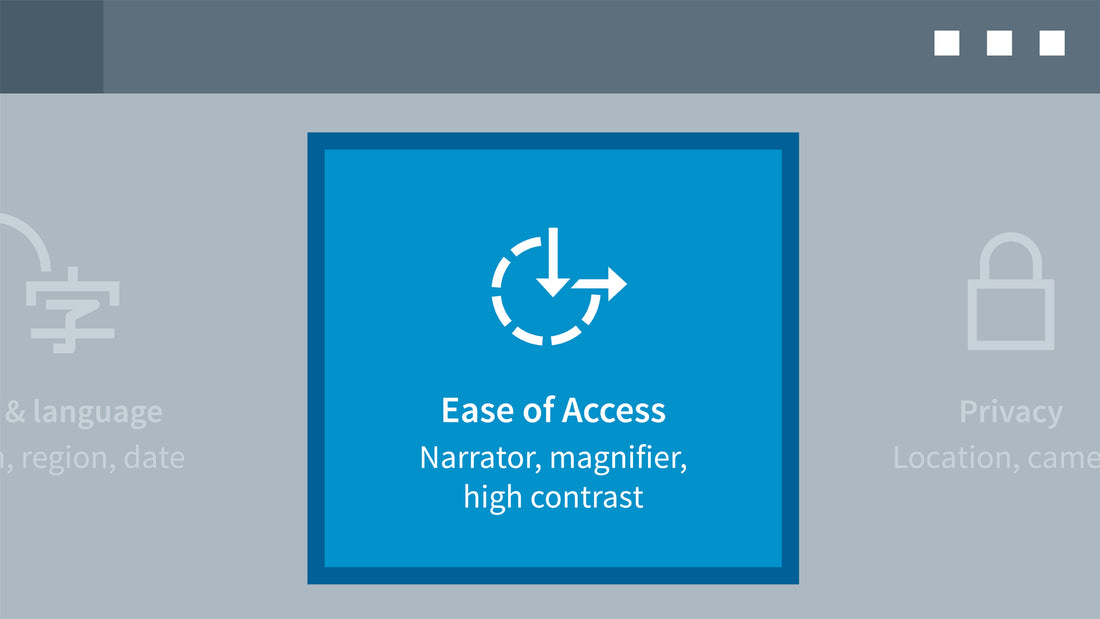
Make Your Windows 10 Computer Low Vision Accessible
WINDOWS 10 LOW VISION ACCESSIBILITY
Navigate to the Ease of Access Windows Settings by pressing the Windows Key + “U” or navigate visually by using the mouse to click on the Windows logo in the lower left corner, then click on the icon above the power button that looks like a cog wheel / gear. From the options, choose “Ease of Access.”EASE OF ACCESS - DISPLAY
- You’ll first be brought to the Display settings, a subcategory of Vision in Ease of Access. Here, you can enlarge the text of your computer by dragging the slider from left to right. Increasing the text size too much can negatively affect the way your computer displays various programs. I suggest not going any further than 150%.
- Scrolling down in Display settings, you can “make everything bigger,” which means the size of your applications, toolbar, and text will all increase in size. The computer does not recommend increasing this, since it can also negatively affect how various programs, websites, etc. can show up, leaving the chance of cutting off text and buttons from being accessed. If you wish to enlarge the display, I recommend staying below 125%. If you wish to customize the size to a percentage between 100-125%, click on “change the size of apps and text on other displays,” scroll to Scale and Layout, click on “Advanced Scaling Settings”, then enter a custom scaling size and click “Apply.”
- Scrolling down further in the Ease of Access Display settings, we come across “Simplify and personalize Windows.” Here, we want to turn “Show transparency in Windows” and “Automatically hide scroll bars in Windows” to Off.
- Last, click on the bottom link that says “Personalize your background and other colors,” which will lead us to edit our computer’s theme and desktop background.
PERSONALIZATION - BACKGROUND
- Many people find it hard to see the text for their desktop icons when utilizing the computer because most background images do not provide enough contrast. To solve this issue, we can change our desktop background to black, increasing the contrast of each app icon and label. Start by clicking the dropdown menu for Background and choose “Solid Color.” If black is not an option, choose Custom Color and create it.
- Next, go to your desktop and ensure that this background color makes it any easier for you to distinguish, read, and access things on your desktop. If it doesn’t, you can pick and choose a color that suits your visual needs.
- You can also increase the size of the items on your desktop. To do this on your desktop, right click in an open area. In the menu that pops up, hover to “View” and continue to hover over the different options, small, medium, and large. Choosing Large will increase the size of your desktop shortcuts greatly.
PERSONALIZATION - COLORS
You may have heard of something called Dark Mode recently that is meant to change your device from having a white background with black text (such as this printed document), to a black background with white text. This feature can play a critical role in helping low vision users increase proficiency and efficiency with their cell phones simply because of the increased contrast provided by the inversion of the two colors. I recommend trying this feature to determine preference for color contrast and theme.
- To change your theme from the default “Light Mode” to “Dark Mode”, you can right click on your desktop in a blank area and choose “Personalize” from the drop down menu. From there, choose the “Colors” subcategory on the left side toolbar. In Colors, click the drop down menu under “Choose your color” and choose between Light or Dark. Next, set Transparency effects” to Off. You can then choose your accent color. This is not as important, so feel free to choose whatever color works best for you. Below that, scroll to “Show accent color on the follow surfaces” and make sure both options are not selected.
EASE OF ACCESS - MOUSE POINTER
- Going back to our Ease of Access settings, we can move from the Display subcategory to Mouse Pointer. Here, we can drag the slider from left to right to increase the size of our mouse pointer. We can also change the pointer color. I recommend choosing the third option, which will constantly be switching between black/white depending on the background it is on, or the fourth option where you can select from and create a custom pointer color that stands out to you.
EASE OF ACCESS - TEXT CURSOR
- The text cursor indicator is meant to help those who lose track of their place while typing by placing small color-customizable balloon-shaped indicators at the top and bottom of the text cursor. You can increase the size of the balloon-shaped indicator on the text-cursor by dragging the slider from left to right.
- You can also change the text cursor appearance and make it much thicker than it normally is. I do not recommend making it too thick because it can become confusing.
EASE OF ACCESS - MAGNIFIER
Windows has a built-in magnifier for enlarging what’s on your screen without having to change the text size or display size.
- Start by switching “Turn on Magnifier” from Off to On.
- Scroll down to “Change zoom increments” and change the increment from 100% to 10%.
- To ensure this turns on when you log-in, be sure to enable “Start Magnifier after Sign-in.” If you wish to be able to use the magnifier before signing in, while choosing your account and inputting your password, you can select “Start Magnifier before sign-in for everyone.”
- Check “Smooth edges of images and text.”
- Scroll down to Change Magnifier View and, from the dropdown menu, choose Full Screen for your view.
- Below that, scroll to “Have Magnifier follow” and check “Mouse Pointer”, “Keyboard Focus”, and “Text Cursor”
- For “Keep the mouse pointer” and “keep the text cursor”, choose “Centered on the Screen” for both from the dropdowns.
- Continue scrolling and you will come across the Reading category with the option, Reading Shortcut. The reading shortcut is a great way to have things on your computer read aloud to you that you otherwise might not be able to read on your own, or would have to strain yourself with magnification to read. If your keyboard has an Insert key, I recommend changing the shortcut from Ctrl + Alt to Insert because it requires less key commands. To then utilize your Reading Shortcut, you would simply hold down the shortcut key that you’ve chosen and click on the text that you want read aloud. Press any key to stop reading.
Now to utilize the magnifier and read from here features, we have keyboard shortcuts.
To invert the color of your screen fully, perhaps if you want to write a word document with white text on a black background instead of black text with a white background, you can use the Invert Colors shortcut of CONTROL + ALT + “i”.
To increase the magnification, hold down the WINDOWS KEY while pressing the PLUS (=/+) key.
To decrease the magnification, hold down the WINDOWS KEY while pressing the MINUS (-/_) key.
To read from mouse pointer: Reading Shortcut + Mouse Click
To start, pause, and resume reading: Reading Shortcut + Enter
To stop reading: Any Key.
To read previous sentence: Reading Shortcut + “H”.
To read next sentence: Reading Shortcut + “K”
WEB BROWSERS - MICROSOFT EDGE:
If you are unsure what a browser is, I’ll start by saying it’s what we use to get on the internet and “surf” the web. Examples of Internet Browsers are Mozilla Firefox, Microsoft Edge, and Google Chrome. I recommend using Microsoft Edge on Windows 11 because of its inherit integration and support and as well as similarities to the best parts of Google Chrome.
MICROSOFT EDGE - IMMERSIVE READER:
When you are in Microsoft Edge in Windows 10 or 11, you can press the F9 key while reading an article or webpage and it will convert the text into what it calls the “Immersive Reader.” The Immersive Reader simplifies web page layouts, removes clutter, and helps customize your reading experience. Upon pressing the F9 key, you will be taken to Immersive Reader where you can change the text size, text spacing, font, and column style. In addition, you can have the text read aloud. This can be done at any point in or out of the Immersive Reader while in Microsoft Edge using the Microsoft Edge Read Aloud feature. To activate this feature, you can either perform the shortcut Control + Shift + “U”
WEB BROWSER EXTENSIONS FOR LOW VISION
High Contrast Extension: Provides an enhanced contrast, white text on black background, or yellow text on a black background in your web browser. Search and download this extension in Google Chrome or Microsoft Edge only.
Dark Reader Extension: Provides a white text on black background option and allows for greater contrast or brightness settings in your browser. Search and download this in Chrome, Edge, or Firefox.
WINDOWS SHORTCUTS:
- MINIMIZE WINDOW:
- WINDOWS + “M”
- GO TO DESKTOP
- WINDOWS + “D”
- ZOOM IN WITH MAGNIFIER
- WINDOWS + “+”
- ZOOM OUT WITH MAGNIFIER
- WINDOWS + “-”
- INVERT SCREEN COLOR
- CTRL + ALT + “i”
- EASE OF ACCESS SETTINGS
- WINDOWS + “U”
